Easy Chicken Feed Savings and Coop Care Tips
- March 6, 2024
- 0 comment
In the quest for sustainable poultry farming, two critical aspects stand out: cost-effective chicken feed and efficient coop maintenance.
This comprehensive guide dives deep into how to minimize costs while ensuring your chickens are healthy, happy, and productive.
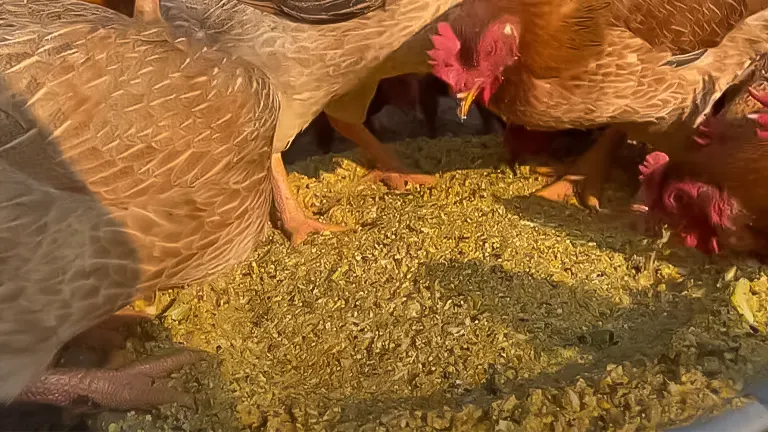
We’ll explore innovative strategies for feeding your chickens on a budget and maintaining a clean and safe environment for your flock.
Table of Content List:
- Maximizing Nutrition with Affordable Chicken Feed
- Homemade Feed Mixes: A Cost-Effective Solution
- Disinfecting the Coop: Ensuring a Healthy Environment
- The Importance of Regular Maintenance
- Egg Harvesting: Maximizing Quality and Quantity
- Strategies for High-Quality Egg Production
Understanding of Basics for Chicken Feed and Optimal Coop Maintenance
Mastering the essentials of chicken feed and coop maintenance is key to a healthy and productive flock. A balanced diet for chickens encompasses proteins, carbs, fats, vitamins, and minerals, with affordable feeding options like homemade grain mixes and kitchen scraps, supplemented with calcium for strong eggshells.
Coop upkeep is equally vital, requiring regular cleaning to thwart bacteria and pests, and ensuring the coop is well-ventilated, spacious, and secure. This combination of nutritious feed and a clean, comfortable living environment promotes the well-being and productivity of chickens, offering a rewarding poultry-keeping venture.
1. Maximizing Nutrition with Affordable Chicken Feed
Finding cheap chicken feed that doesn’t compromise on nutritional value is crucial for the health and productivity of your poultry. One effective strategy is utilizing local agricultural resources. For instance, growing your own vegetables, like cabbage, can significantly reduce feed costs.

At merely $1 for 12kg, vegetables offer an incredible value for money, providing essential nutrients to your chickens. Additionally, incorporating a mixture of corn, seashells, cabbage, and fermented black sticky rice into your chicken’s diet can offer a balanced nutritional profile that supports growth and egg production.
2. Homemade Feed Mixes: A Cost-Effective Solution
Creating homemade feed mixes can be a game-changer for your poultry farm. By mixing corn, crushed seashells, cabbage, and fermented black sticky rice, you can create a high-quality feed that rivals commercial feeds at a fraction of the cost.
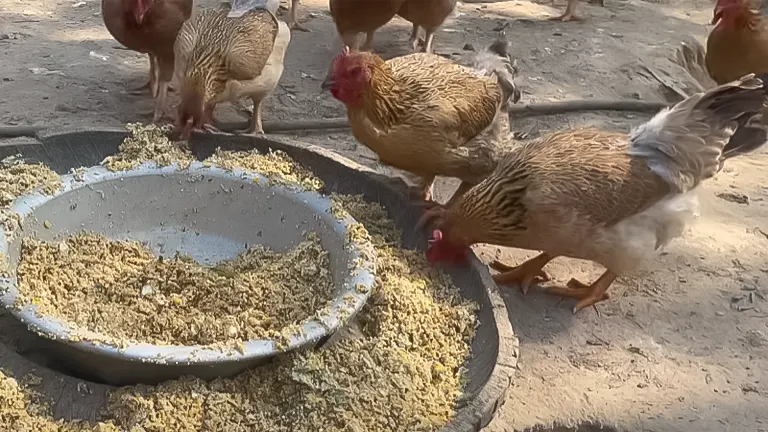
This mix not only supports the health and growth of your chickens but also contributes to higher quality egg production, particularly in breeds that thrive on a diverse diet.
3. Disinfecting the Coop: Ensuring a Healthy Environment
A clean coop is paramount for preventing disease and promoting a healthy living space for your chickens.
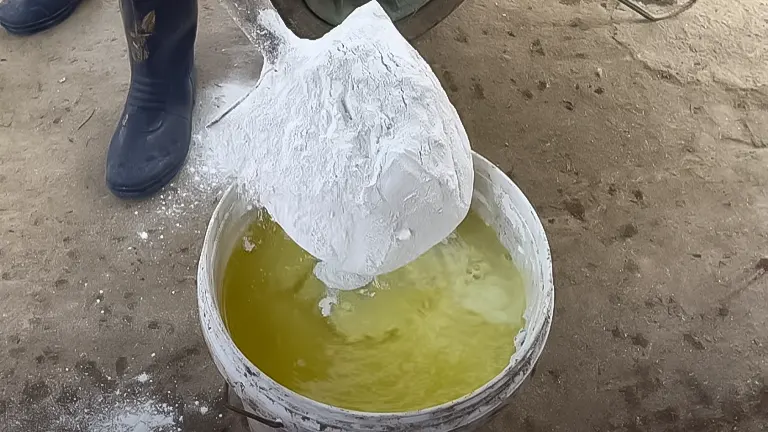
Disinfecting your coop regularly with natural solutions like neem leaves soaked for a week mixed with lime powder can create a safe and hygienic environment.
This method is not only effective but also environmentally friendly and cost-efficient.
4. The Importance of Regular Maintenance
Regular maintenance, including whitewashing the coop floor, is essential for preventing parasites and diseases.
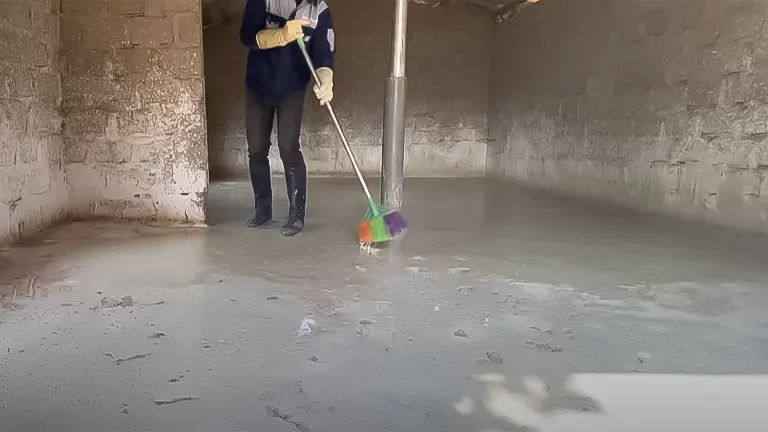
Planning these maintenance activities, such as cleaning and disinfecting the coop before introducing new chicks, is crucial for maintaining a healthy flock.
5. Egg Harvesting: Maximizing Quality and Quantity
When it comes to egg harvesting, the quality of the eggs is significantly influenced by the chicken’s diet and the cleanliness of the coop.
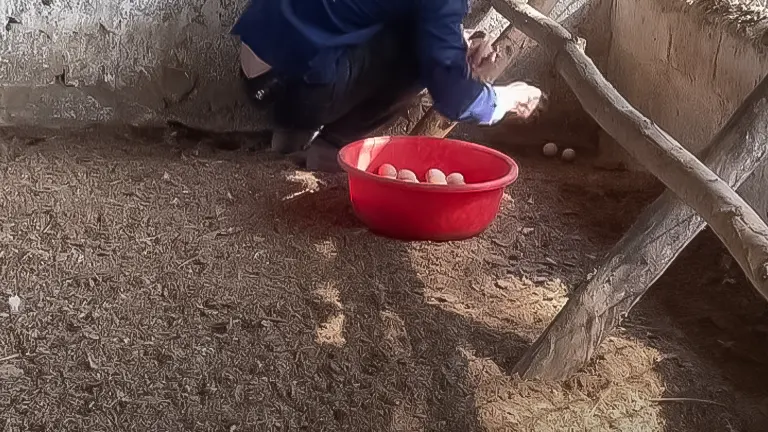
Feeding chickens a balanced diet and maintaining a clean nesting area can lead to higher quality eggs and more efficient egg production. This not only benefits the health of the chickens but also the profitability of your farm.
6. Strategies for High-Quality Egg Production
To produce high-quality eggs, it’s important to focus on the breed of chicken and their specific dietary needs.
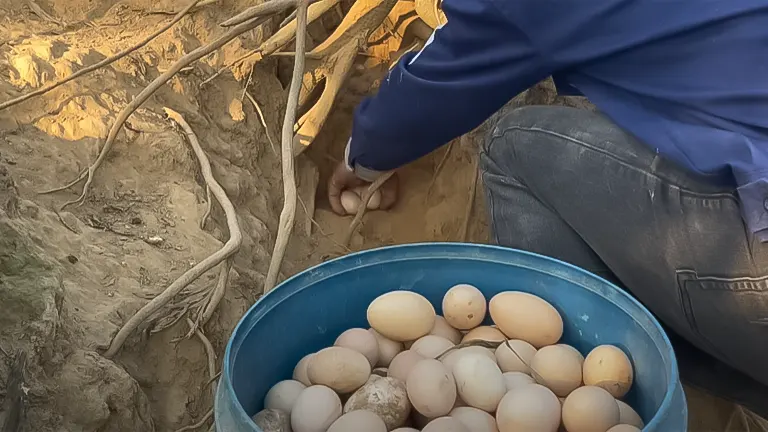
For instance, while super meat chickens may lay fewer eggs, their eggs tend to be of superior quality due to the natural secretion processes and a nutritious diet.
This highlights the importance of choosing the right chicken breed and feed composition for your specific goals.
8 Tips for Cost-Effective Poultry Farming
- Utilize local agricultural resources for feed to reduce costs.
- Create homemade feed mixes to ensure a balanced diet for your chickens.
- Disinfect the coop regularly with natural solutions to maintain a healthy environment.
- Conduct regular maintenance tasks to prevent disease and parasites.
- Optimize your chicken breed selection based on your egg or meat production goals.
- Implement efficient egg harvesting practices to maximize quality and quantity.
- Recycle and reuse resources within your farm to minimize waste.
- Stay informed about the latest poultry farming techniques to continuously improve your operations.
10 Safety Management and Maintenance Procedures
- Regular Inspection and Cleaning: Conduct weekly inspections of the coop to check for signs of wear, damage, or pest infestation. Clean the coop thoroughly, removing droppings, leftover feed, and replacing bedding material to maintain a hygienic environment.
- Pest Control Measures: Implement proactive pest control strategies, such as sealing gaps in the coop to prevent rodent entry, using diatomaceous earth to deter mites and lice, and maintaining cleanliness to reduce attraction for pests.
- Proper Ventilation: Ensure the coop is well-ventilated to prevent the buildup of ammonia and moisture, which can lead to respiratory issues in chickens. However, avoid drafts directly on the birds, especially in colder climates.
- Secure and Safe Housing: Regularly check the coop’s structural integrity and security features to protect chickens from predators. Ensure locks are functional and repair any damage to fences or enclosures promptly.
- Nutritional Feed Management: Store chicken feed in a cool, dry place to prevent mold growth and spoilage. Use airtight containers to deter pests and maintain the nutritional quality of the feed.
- Water Quality and Availability: Provide constant access to clean, fresh water. Clean water containers daily to prevent the growth of algae and the spread of diseases.
- Proper Disposal of Waste: Designate an area for composting chicken manure and bedding materials. Regularly turn the compost to facilitate decomposition and prevent the attraction of pests.
- Seasonal Adjustments: Adapt coop maintenance routines to seasonal changes, ensuring adequate warmth in winter through insulation or heat lamps, and sufficient cooling in summer through additional ventilation or shading.
- Feeding Equipment Maintenance: Clean and inspect feeding troughs and dispensers regularly to prevent the accumulation of old feed, which can attract pests and harbor mold.
- Health Monitoring and Care: Keep a close eye on your chickens for any signs of illness or distress. Implement a quarantine protocol for any new or sick birds to prevent the spread of disease within the flock.
Following these safety management and maintenance procedures will help maintain a clean, secure, and healthy environment for your chickens, while also ensuring the affordability and nutritional adequacy of their feed. This comprehensive approach is essential for the well-being of your flock and the success of your poultry-keeping endeavors.
Related Articles:
- Best Bedding For Chickens
- Best Safe Chicken Coop Heater
- 8×8 Chicken Coop Plans
- Turning a Shed Into a Chicken Coop
- How to Make a Chicken Coop Out of Pallets
- Best Sand for Chicken Coop
- How To Insulate a Chicken Coop
- How To Heat a Chicken Coop
- How To Keep Water from Freezing in Chicken Coop
- How to Build a Chicken Coop
- How To Build Chicken Nesting Boxes
- How to Raise Happy and Healthy Chickens in Your Backyard
- When Can Chicks Go Outside? Timing and Tips for a Smooth Transition
- 12 Reasons why Ducks are Better than Chickens
- Best Automatic Chicken Coop Doors 2024: Expert Reviews & Buyer’s Guide
- Best Fans for Chicken Coop 2024: Effective Cooling Solutions Reviewed
- Transforming Chicken Feed: My DIY Black Soldier Fly Bin Experience
Final Concluding Thoughts
Effective poultry farming requires a balance between cost-efficiency and optimal health conditions for your chickens. By adopting strategies for affordable chicken feed and maintaining a clean and safe coop, you can achieve sustainable success in your poultry farming endeavors. Whether you’re growing your own feed or optimizing your coop maintenance routines, each step you take towards efficiency can have a significant impact on your farm’s productivity and profitability.
Frequently Asked Questions
- What are the most cost-effective ingredients for homemade chicken feed?
Utilize a combination of grains such as corn and wheat, protein sources like soybean meal or dried legumes, and add greens or kitchen scraps. For calcium, ground eggshells or oyster shells can be included. - How can I ensure my chicken coop is properly disinfected?
Use a natural disinfectant solution, such as a mix of water, vinegar, and lemon juice. For more thorough disinfection, diluted bleach or a commercial coop cleaner can be applied, followed by adequate ventilation before reintroducing the chickens. - What is the ideal size for a chicken coop?
The coop should provide at least 2-3 square feet of space per chicken inside and 8-10 square feet per chicken in an outdoor run. - How often should I clean and disinfect my chicken coop?
Perform a deep clean and disinfection at least twice a year, with more frequent spot cleaning and litter changes as needed to maintain hygiene and prevent disease. - What are some affordable yet nutritious feed options for chickens?
Besides commercial feed, you can supplement with kitchen scraps, garden produce, and grains. Fermenting your chicken feed can also increase its nutritional value and digestibility. - Can I grow my own feed, and if so, what should I plant?
Yes, growing your own feed can significantly reduce costs. Consider planting corn, wheat, millet, sunflowers for seeds, and leafy greens like kale and Swiss chard for additional nutrition. - How can I naturally prevent pests in the chicken coop?
Maintain cleanliness, use diatomaceous earth in bedding to deter mites and lice, and plant herbs like lavender, rosemary, and mint around the coop to repel pests. - What are the signs of a well-maintained chicken coop?
A well-maintained coop is clean, well-ventilated, free of pests, and provides ample space, nesting boxes, and roosting bars for the chickens’ comfort. - How can I make my chicken coop environmentally friendly?
Use sustainable materials for coop construction, implement solar panels for lighting, collect rainwater for cleaning, and compost chicken manure. - What should I consider when choosing bedding for my chickens?
Bedding should be absorbent, easy to clean, and replaced regularly. Pine shavings, straw, and sand are popular choices for their absorbency and ease of use in composting chicken manure.
Remember, the journey to sustainable poultry farming is continuous, and staying informed about the latest techniques and practices is key to staying ahead. For more insights and strategies on optimizing your poultry farm and boosting its performance, don’t hesitate to explore further resources.

Edward Smith
Forestry AuthorWoodworking is about more than crafting; it's a harmonious connection with nature, mastering tools, and preserving our environment. I'm here to share my knowledge and experiences with you, forging a future where we can embrace wood's beauty and utility while safeguarding our forests' health and diversity.













Leave your comment